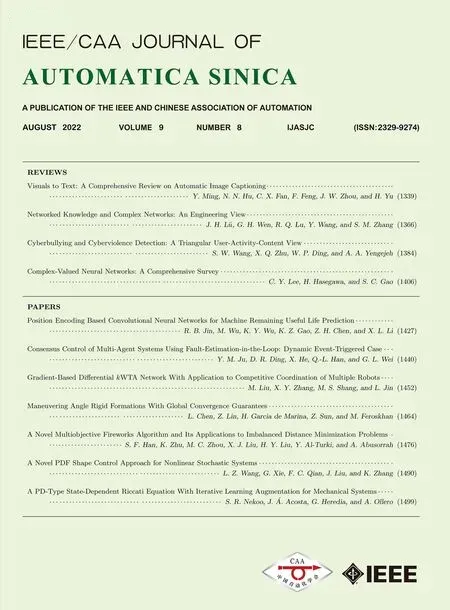Finite-Time Stabilization of Linear Systems With Input Constraints by Event-Triggered Control
Kai Zhang,, Yang Liu,, and Jiubin Tan
Dear editor,
This letter designs the event-triggered control (ETC) to achieve finite-time stabilization (FTS) of linear systems with input constraints. The key idea of the established algorithm is that the designed time-varying high-gain is only scheduled on a specified time determined by an event-triggered mechanism. By exploring the properties of the parametric Lyapunov equation, a positive lower bound of inter-event times associated with the designed ETC can be obtained, such that the Zeno phenomenon is avoided. Moreover,semi-global FTS of linear systems with input constraints is also achieved by the designed ETC. Finally, the application of the spacecraft rendezvous control system verifies the effectiveness of the designed ETC.
Related work: With the advancement of computer and communication technologies, (shared) wired and wireless networked control systems (NCSs) have been an increasing popularity since they have the merits of high flexibility, efficient reconfigurability,and low cost on the installation and maintenance compared to the conventional point-to-point digital control system [1]. However,NCSs may meet some new challenges such as network traffic congestion, which cannot be solved well by using traditional periodic sampling control. Due to the reason, the ETC algorithm that can greatly save communication resources has been paid much attention.Especially the appearance of the literature [2], which greatly promotes the systematic design of ETC methods [3]. Since then,many results for ETC have also been emerged and can be found in[4], [5] and the references therein.
Since the saturation nonlinearity is ubiquitous among every practical system, the ETC of systems subject to input constraints has also received much attention. For example, the local exponential stability of the linear system with input constraint has been achieved by the simultaneous design of a state feedback law and an eventtriggering condition in [6]. The global stabilization of general linear systems with input constraints has been well achieved by the nonlinear ETC algorithm in [7]. A controller based on the general Riccati equation was designed in [8], where the event-triggered mechanism is conservative and the solution of the parameters is too complicated. Recently, a series of ETC algorithms based on the parametric Lyapunov equation (PLE) have been designed in [9], [10],where the relationship between the design parameters and the minimal inter-event time (MIET) is clearly and simple.
In addition, the faster convergence (even finite-time convergence)is pursued in reality and some corresponding results have been obtained in [11]–[13]. Since the ETC algorithm with performance of FTS can obtain a rapid convergence rate with less cost on the communication resources, it is very meaningful and has received much attention. For example, an ETC method with an exponential time-varying gain was designed to achieve FTS of nonlinear systems in [14]; global FTS of a class of uncertain nonlinear systems has been achieved by designing an ETC based on the backstepping technique in [15]; finite-time path following of underactuated vessels has been achieved by designing an adaptive neural network ETC in [16]. More results can be found in [17] and the reference therein. Nevertheless,the input constraints are not considered in the above mentioned articles, which is not expectable in practice since any practical actuators can only generate bounded control signals. To the best of our knowledge, how to design an ETC with an easily designable MIET to achieve FTS of linear systems with input constraints has not been well investigated.
Motivated by the above discussion, we aim to establish an ETC algorithm to achieve FTS of linear systems with input constraints.This is done by designing the PLE based time-varying high-gain feedback that is only scheduled at a specified time determined by an event-triggered mechanism. Specially, in the designed ETC, a clear MIET that avoids the complicated relationship with system matrix is given such that the Zeno phenomenon is avoided and a trade-off between communication resources and the stabilized time can be easily found. Finally, the established algorithm is used to the design of the spacecraft rendezvous control system.






Fig. 1. The relative distance and control signals under different values of β.


Table 1.The MIET/AIET/TNS Associated With Theorem 1


Fig. 2. The relative distance for different methods.
Conclusion: This letter designed an ETC to achieve finite-time stabilization of linear systems with input constraints. The key idea is that an event-triggered mechanism is designed to update the control law, where the control gain based on the solution of the parametric Lyapunov equation will approach to infinity at finite time. The Zeno phenomenon was avoided for the ETC algorithm. In the future, we will design the dynamic event-triggered control to increase the interevent times and self-triggered control algorithm to avoid continuously monitor of system states.
Acknowledgments: This work was supported in part by the National Natural Science Foundation of China (52075132,51907038) and the State Key Laboratory of Digital Manufacturing Equipment & Technology (Huazhong University of Science and Technology) (DMETKF2020024).
 IEEE/CAA Journal of Automatica Sinica2022年8期
IEEE/CAA Journal of Automatica Sinica2022年8期
- IEEE/CAA Journal of Automatica Sinica的其它文章
- Consensus Control of Multi-Agent Systems Using Fault-Estimation-in-the-Loop:Dynamic Event-Triggered Case
- A PD-Type State-Dependent Riccati Equation With Iterative Learning Augmentation for Mechanical Systems
- Exploring the Effectiveness of Gesture Interaction in Driver Assistance Systems via Virtual Reality
- Domain Adaptive Semantic Segmentation via Entropy-Ranking and Uncertain Learning-Based Self-Training
- Position Encoding Based Convolutional Neural Networks for Machine Remaining Useful Life Prediction
- Gradient-Based Differential kWTA Network With Application to Competitive Coordination of Multiple Robots
